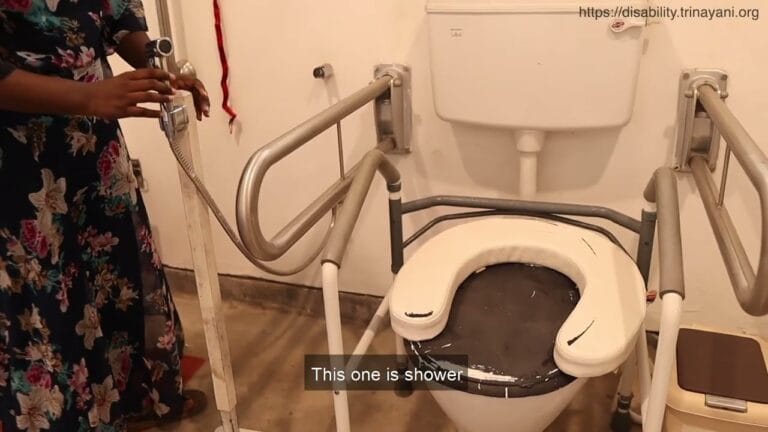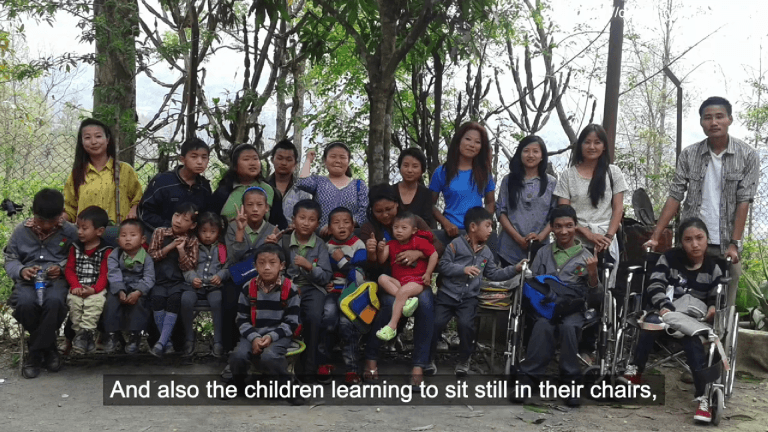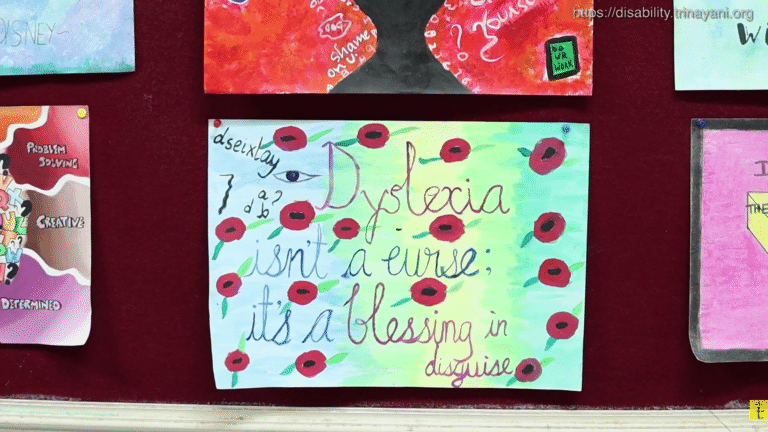Specific Learning Disability
Do you remember the little boy from the Bollywood film, ‘Taare Zameen Par’? Remember how his teacher, Aamir Khan helps him make sense of alphabets and numbers?
About 19% of school-going children in India have learning disabilities. We spoke to Ms Padma Shashtry, an expert with an impressive 30 years of teaching experience, whose expertise lies in working with students facing various mild to moderate disabilities, fostering inclusive classrooms and advancing teacher education.
In this film, Ms Shastry touches upon Learning Disabilities. She delves into the neurological and behavioral aspects arising from academic frustrations in children and shares valuable insights into identifying, assessing and supporting students with learning disabilities in the classroom. With practical strategies and a focus on teacher training, she advocates for an inclusive approach to education, aiming for the success and well-being of every student.
Namaskar and Hello, my name is Padma Shastry and I’m a special educator and I have worked with students in an inclusive setting which means my students have been included in the mainstream classroom.
Most of my class students are, most common thing I see with my students is a specific learning disability which is what I’m going to be talking about today.
So what is a specific learning disability?
Um it’s an umbrella term that includes a lot of different processes that happen in the brain.
Specific learning disability is a neurological condition which starts in the brain and then it gets expressed in in in in words, in fingers, in in the muscles of the legs, so you see you know walking problems, writing problems, math problems and reading problems and all of that that happen in the classroom.
So a specific learning disability is a very, it starts out as an academic difficulty which is where it is first noticed and then on top of it there’s a second layer of behavioral issues that come on later, that comes mostly from the frustration that is felt over time in an academic setting.
And uh… specific learning disability is not a medical condition in the sense it is not identified by a blood test or an x-ray or an MRI or any of that sort, uh… it is an academic situation where the teachers notice it and the parents struggle with it at home and it is identified, it is, we don’t use the word “diagnosed” with it because diagnosis is a medical term and here we are trying to identify students who have academic difficulties and so it is identified first in a school and then it is assessed by a special educator who will determine what kind of processing difficulty is happening in the brain.
Is it a perception problem?
Is it a memory problem?
Is it an attention problem?
And all of that is um uh we can get all of that through an assessment program and that is how we identify that a student has a specific learning disability.
A specific learning disability can be a comorbid condition.
We see it frequently in students with autism, we also see it in students who have spina bifida maybe or we also see it in students who are undergoing a treatment for a condition such as cancer.
All that chemotherapy or anything else that they’re going through, any other kind of treatment they’re going through, has an effect on their brain, their memory suffers their processing speed reduces so we do see it as a comorbid condition.
Of course we also see specific learning disability in and of itself in the classroom as well.
So the way we identify it usually is by the discrepancy model uh in a discrepancy model we see that there is a discrepancy between potential and achievement and then we wonder if the potential is there why is the achievement low?
And there’s a discrepancy between their potential and the achievement and this is what we measure.
We measure potential by IQ and we measure achievement by what is happening in the classroom and then we see that there is a difference and this is what the assessment measures and based on that we determine that the student has a specific learning disability.
So right now I’ll be talking about some screening criteria, what teachers see in the classroom uh when they might that, that would lead them to think if that the student might have a learning disability.
One of the first things that they are going to notice, as well as the students and the parents are going to notice, is a report card that is falling, where the students start struggling and the marks are low, a failing grade on exams and tests and that is the first indication.
This is after all an academic thing so until students come to school this might not be that apparent and once school and exam start you, they will start seeing a failing report card that is the first thing that everybody notices.
Uh students are going to be very disorganized, they will lose their papers, they will bring the wrong, books they will forget their supplies and materials, this is very common.
One of the things that we say is that their backpack look, the condition of the brain is like the condition of their back…backpack, so their brain is just as disorganized which is what shows up in their uh backpack.
Uh homework return, it will be very poor, one day they’ll forget to do it, one day they won’t turn it in, one day they lose it this, this is another thing that you know homework return might be like two days in a week.
Um then you’re going to see reading problems, academic problems, so what is commonly called dyslexia, reading problems, dyslexia is one of the specific learning disabilities as, as is dyscalculia which is a math difficulty or dysgraphia which is a writing difficulty.
So you’re going to see fine motor issues because of what’s happening in the brain because of the learning disability so the whole…holding the pencil is going to be um, you know, off.
They might press too hard, they might write too lightly, they might not hold the pencil properly, not tripod grip, all of this.
Uh you’re going to see academic issues, then they’re going to have trouble following directions.
This is also going to lead to behavior problems or they do the wrong work in the wrong way in the wrong notebook.
They’ll do their science homework in their history notebook and that, that kind of direction following, “Turn the page” if you say simple things like that they are not following along because they’re not hearing it at the moment when you say it.
They have awkward social interactions with friends, they don’t know how to make friends, they don’t know how to ask, how to join a conversation and these things and other kids might think that these kids are a little weird or off and so they might not form close uh friendships.
And if they are frequently struggling with academics and if they have um you know, constantly failing report card their low, their self-esteem will be low, they will um sort of act out in other ways because their self-esteem will be low.
Uh they will develop behavior issues, two to three years of failure and struggles will lead to behavior issues, so they will refuse to do the work that you ask them to do, they will break the pencils, they’ll throw the notebooks, uh they’ll throw tantrums depending on their age.
It shows up in different ways, but it is bound to happen that when a person struggles then it is going to show up in their behavior over time.
In the beginning they will try and even after trying and even after your help if they continue to struggle then it will turn into a behavior problem, an academic problem turns into a behavior problem over time.
And so um difficulties will progress as school complexity increases from second grade they go to third standard, fourth standard, each grade the complexity increases, the difficulty level increases, then they are going to you know, the difficulties also will increase and their behavior and everything will just fall cumulatively behind.
And so at this point if you see any of these signs do talk to the parents of the student and see about getting the student assessed for a learning disability.
Here are a few academic strategies I’m going to be sharing with you um here is an overlay grid.
This is basically a piece of graph paper, you can use any kind of graph graph paper.
Uh if you are using an overhead projector you can make a transparency of the overlay grid and lay it on top of a map or on top of a scientific drawing, the human body or anything that the students are learning in your class, and if you want them to locate names of cities like, “where is Delhi?” on this map and the kid is looking all over, the student is looking all over the map and you can say “Delhi is in E2” and the kid is able to locate where Delhi is on the map.
So, or you can give this overlay map to a student at his desk to use uh so any, any kid who’s struggling with too much information on the board, an overlay grid can help.
Another strategy, these are called line guides.
I just printed them off of Google so you can just print them off of Google.
These are really interesting uh because if you want your student to do a final publication of, of some piece of writing and they are writing on blank paper, you know, their writing will go from top to bottom on slanted lines, so this, if you put it behind a sheet of white paper, they can write along uh straight lines and their final product looks neat and good.
Um my kids used to use it, put it against a window glass and write so that the light from the window would show them the lines nicely.
Now some of the work that we do in the classroom as teachers, I have put a post-it here.
This is an example of “Do not do”.
So what is it that you should not do for a student who has organization problems and you know all of that going on in the brain?
Where the, where the crossword is on page one and the clues are on the back page, this frequent turning makes it very difficult for a student to keep up with the work.
So please put the clues and the crossword on two pieces of paper so they have both next to each other when they are working, makes it much easier.
Another strategy that I have frequently use with my students is to create a Word Bank like this where they write, they draw a picture, this this is very useful in mathematics and science, where they can draw a picture of the term that they are, the new term that they are learning and then write a definition and then they write down the page number where that term is in their textbook.
So if the, if the term that they’re learning is let us say, “liver” they write the word “liver” and they write down page 318 and they draw a piece of, they draw picture of liver and then write down what it is, it’s an organ inside the human body near the stomach etc. etc.
So this is something that they can use very easily before their exams, we can…useful to do a review.
Another strategy is what’s called Cloze Notes, c-l-o-z-e, Cloze Notes.
Cloze Notes are when a student has trouble writing and you are expecting them to write a whole bunch of notes from copying from the board it’s a lot of writing and they can’t keep up sometimes, so what you can do is give them a copy of the notes with fill in the blanks spaces, so that they are following along with your teaching and they’re following along with the notes but they’re not writing every single word they’re only writing the keywords.
So if you can create these ahead of time and give it to three, four, three or four students who are struggling in your classroom, that is something that will be immensely helpful.
Okay, another strategy that we can use that I have also used, I’m only explaining a few strategies, there are many more of course, but today we’ll look at a few, this is a way of teaching them how to write a summary.
We generally say things like, “write a paragraph”, “write a summary”, “write a story”, but if you can’t, it’s a big project in a student’s brain, it’s a huge thing and they don’t know how to get started, so if you can break it up into steps and use a graphic organizer, graphic organizers are lifesavers for these kids and for teachers and so we teach them how to write something, we use a graphic organizer that takes them one step at a time and based on what you have helped them with on page one they can actually write a small paragraph on the second page.
So this is something that is very useful and it also shows them that it’s not a big project and it can be broken up into small steps.
Now we move on to some testing strategies, how do you modify testing?
Um, testing is a nightmare for students with difficulties.
It is a nightmare for all students and students with learning disabilities struggle even more with it.
So one of the ways I have modified a history test if you notice here, I have page numbers, this is an open book test and I have page numbers here, where they’re going to find the answers to these fill in the blanks.
And I give them a textbook and they turn to these page numbers in order to find the answers.
Major questions of fairness will come up at this point, “is it okay to do this?”, “what are they learning?”
First of all, they might, they are learning they will learn over time and we do wean these strategies away over time.
This is not a lifetime get out of jail free card.
It’’s not something that they get forever, this is a strategy to help them succeed and we will generally slowly pull them back and pull back these supports.
But even if they are not learning the actual answers to these and questions they’re learning how to use a textbook.
So they’re learning how to turn to the you know Rome section of the history book and find the answers about Rome and in the process of finding the answers they’re actually reading through the text.
So they are learning and this again is not to be used all there, for 10 years in school.
It’s to be used so that they get to the next mature step.
Another strategy we use to modify tests, this is an example of a math test. Here you have the actual math exam, this is the problem that is actually on the test.
I have given an exact copy, a sample here, which I have worked out. They go through the sample and they repeat it for the actual exam question.
So students with specific learning disabilities can have memory issues, memory problems. So they might not remember how to do the test but how to do the problem, but once they see the problem there’s like “oh yeah this is what I have to do” and then they can repeat it.
And again, this is not going to happen all 10 years of their school life. We are going to wean it back.
Another pet pep peep of mine is when we do a spelling test without sentences.
Spellings have to be in context.
Students do much better spelling when they have context, so give them a spelling test using complete sentences, uh and even for adults if I say spell “two”, which two are you going to spell is it going to be “t-o” is it going to be “t-o-o” or is it going to be “t w o”.
Context makes all the difference.
So when you give students spellings tests, please use complete sentences. So, these are some strategies.
There are several more but I hope these will help you in the classroom right away.
Here are some behavioral strategies that you can use in the classroom.
You will have frequently discovered that students with learning difficulties also have behavioral difficulties. So here are some strategies that might help.
One of the important maxims that we remember, as we have to remember as teachers, is that behavior improves when students succeeds.
It is the constant struggling and failure that creates the behavior issues.
So here are some strategies. um certain behaviors, just accept, don’t fight it. For example a fidgety kid, a kid who moves around a lot, who needs a large personal space, it’s like whack-a-mole, you can’t keep saying sit down sit down sit down and then that mole in that arcade game keeps popping up, popping up, popping up like popcorn.
So there’s no point continuously fighting this, you are annoying yourself as well as a student. So might as well accept it.
So what do you do with a student who keeps standing up like popcorn all the time and obstructing the view for the students in the back and disrupting.
Put them along the edges of a classroom. Put them along, put their desk along this edge or in the back of the classroom or along the sides where they don’t obstruct anybody.
Give them a standing desk, where they can dance on their feet and continue to work in the classroom. So the standing desk can be in one place out there. They get a regular classroom desk as well so when they finish standing and fidgeting they can come back to their desk.
A standing desk is not a punishment. It is a tool for them to fidget. It is a good thing. So when that fidgety ask them if they want to use the standing desk.
Another thing that you can use, are fidget bands that are tied to the legs of a chair where the kid can kick those fidget bands and keep his legs or her legs in her own space.
Because when kids are fidgeting with their legs they’re kicking the chair in front of them. And to avoid that and to avoid them annoying other students, if you attach elastic bands, bungee cords to the legs of their own chairs, they can keep kicking that.
Another thing that you can do is give them something to fidget with, something to squeeze uh maybe a squeeze ball, so allow for movement in the classroom uh if they really are moving.
I had a student who used to walk constantly to the garbage bin to sharpen his pencil and he would cross in front of the classroom and cross back and he needed to do this three or four times during every period.
If you have a student like that, send that student out on an errand. Ask that student to go to the office to deliver a sheet of paper and come back. Or ask that student to go out and get a drink of water or something like that.
Send them out on a walk around the campus on an errand and ask them to come back. These are some of the strategies that you can use with the fidgety “up and about” kids all the time.
Other behaviors like um you know, undesirable behaviors in the classroom, you can talk to the student and have an age-appropriate behavior plan, which includes some rewards.
If you want a kid to sit in his or her chair for 40 minutes in a class period and the kid is not even able to sit for five minutes without moving, then you make a behavior plan where the kid sits for five minutes and gets a reward and then kids sits for 10 minutes and gets a reward.
And the reward is not something like a uh like a biscuit or a sweet or something like that.
A reward is something like five minutes of computer time or five minutes extra recess or five minutes of 10 minutes of a basketball game or something like that, something that the kid prefers and would appreciate.
A note home to the parent, that, a kid always loves, your student did so well in school today.
And the kids smiles, really nicely, when a good note goes home, because these kids sometimes get so much, so much bad reports going home to their parents, they really appreciate it when you send a note home.
So that is a powerful reward.
Send a note home with a good message. So these are the kinds of rewards that you can give to students who are complying with the behavior plan, whatever you want them to be doing.
Another strategy is to have very good well-established, easy-to-follow classroom routines, where um where the lunchboxes go, where their backpacks go, where their homework goes, where is the bin that collects homework, how does paper get passed out in the classroom, where is the pencil sharpening station.
All of this if it is well established and the kids know where to go, they won’t keep coming up and asking the teacher all the time.
“Where do I put this homework?, What notebook do I need to take out? Where do I put my lunchbox?”
The lunchbox fell down, the food fell on the floor, all of these problems will not be there on an ongoing basis or regularly.
So classroom routines are really really valuable.
And um what do you do with a student who keeps going to the bathroom all the time, three times four times, ten times in a period asks, I want to go drink water, I want to go to the bathroom.
So maybe have a bathroom pass and say three bedroom visits in a day.
And then next quarter you say two bathroom passes in a day, which means that, once they exhaust their bathroom passes for the day they can’t keep asking.
um So you know, it sort of like, gives the student also something, it’s like, oh I only have one more bathroom pass, I can’t keep asking uh to go out.
So it tells the student exactly what the, what the boundary conditions are.
um another student, another strategy is, to help the student to work. See, you will see a difficulty, you will see behavior difficulties when there are academic difficulties.
When this work is too big and overwhelming for the student, the student assumes that he or she cannot do it and won’t even try.
The pencil stays there, the paper stays there, and they won’t even start working.
So if you can give the student work that the student can actually do and get started, then you will see fewer behavior issues.
You will actually see the student trying to work and use that time for work. For example if you give, if you determine the reading level of the student and give a book to the student that the student can actually read, that student will actually spend 15 minutes reading that book instead of giving the student a book that is at grade level, that is too difficult for the student to read and he won’t even start the process of trying to read.
He’ll look at some pictures and then put the book down. And so this works whether it’s for writing or for reading or for any academic subject.
Hope these strategies are helpful in the classroom.
There are many more but we can talk about them later.
Based on my experience as an inclusive teacher in a public school, in the U.S I have two things observations and now I’ve been here for a few years in India I have a couple of observations that I want to share uh with you now.
One of them is about teacher training. A teacher training is very important. When you’re working with students who are struggling whether they’re identified as a special ed or not they are already in your classroom.
So you are already teaching students who are struggling and teacher training is really important. I understand that it might not be always possible but you know in service training or workshops will be really helpful in this regard.
The other point I want to make, and this is a plea to authorities in the design of the B.ED system, where I have observed that special educators are like general practitioners.
We help students across a breadth of disabilities. Because that is what we see in the classroom, versus specialized special education teachers, who help deaf students or blind students or students on the autism spectrum separately.
In an inclusive setting you’re going to find one blind student maybe, one deaf and it’s a group of students with learning disabilities or something like that in one classroom.
So you’re going to find heterogeneity and I think a Special ed degree that helps with all disabilities on a general level is really really, it’s time for it and it’s really really important for inclusive education to flourish.
Resources
academic challenges, assessment strategies, behavior plans, behavioral issues, classroom accommodations, classroom routines, cloze notes, dyscalculia, dysgraphia, dyslexia, fidgeting, graphic organizers, inclusivity, learning difficulties, neurological, organization problems, overlay grid, special education, specific learning disability, teaching methods, testing modifications
Dive Deeper: More on Disability
Learn about the most common inquiries surrounding disability, education, legislation, accessibility, employment and other sectors related to disability.


Playlist
Access & Inclusion


Playlist
Adaptive Sports


Playlist
Alternative Communication Methods


Playlist
Autism & Neurodiversity


Playlist
Blindness & Adaptations


Playlist






